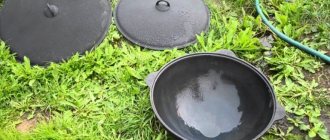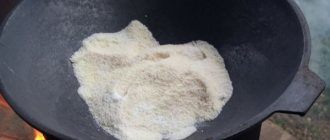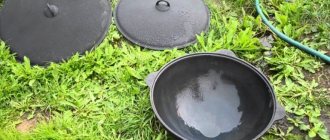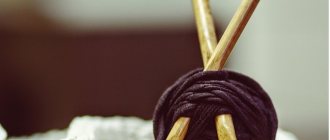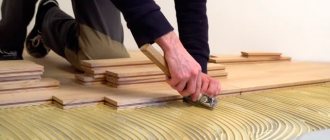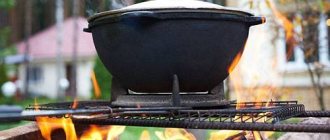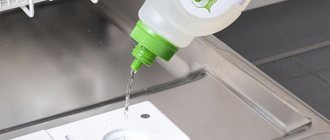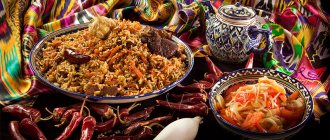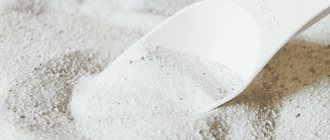Kazan is a semicircular pot for cooking over an open fire. For lovers of hunting, fishing, and hiking, an aluminum or cast iron cauldron is a must. Lovers of oriental dishes will not do without such utensils. Only in a cauldron can you cook real pilaf, lagman and other delicious dishes. You can buy this simple device at any hardware store. However, in order for cooking to be a real pleasure, the food does not burn and cooks evenly, gradually becoming saturated with the aroma of spices and broth, the cauldron in shape and material should be as close as possible to the utensils that are used to being used in Eastern countries.
Operating principle and device
Kazan is traditionally used in Asian cuisine. It is round in shape so that the flame in the hearth evenly heats not only the bottom, but also the walls of the dish. The contents of the cauldron cook faster and stay hot longer, and the aroma of the spices is better absorbed due to the long simmering period of the food.
For modern gas and electric stoves, the same cooking principle applies:
- For stability, the cauldron is placed on a special stand in the form of a tripod;
- heat is evenly distributed both along the bottom of the dish and along its walls;
- increased steam formation occurs, which ensures simmering of the food rather than frying.
When cooking food, the water first receives heat, then it transfers evenly from all sides to the food. If frying occurs, the same principle applies, only the temperature should be lower. It is more convenient to mix food in a cauldron.
A prerequisite for cooking is the presence of a tightly closing lid. It prevents steam from escaping from the cookware. The lid is included and is made of the same material as the cauldron.
Important! There are options with standard 2 handles, like a saucepan. Sometimes cauldrons are equipped with a third, which serves to suspend the container over the fire. This model is convenient for cooking outdoors.
What is the difference between a cauldron and a saucepan?
What does a cauldron look like as opposed to a saucepan:
- It has a semicircular or spherical bottom, the pan is flat.
- The walls and bottom of the cauldron are thicker.
- It's much heavier.
- Capacity depends on the model, but choose a cauldron of at least 5 liters.
- Food stays warm longer in it.
The cauldron usually has the color of the material. The pan looks more attractive: it can be of different colors and decorated with different designs.
Reference. Food in a cauldron burns less than in a saucepan.
Wall thickness and bottom shape
The standard thickness of the bottom and walls of the boiler is 0.3-0.5 cm. It ensures uniform heating, heat accumulation and distribution, as well as preservation.
The inside of the walls should be smooth. If there is a special coating, it spreads evenly, covering the bottom and walls.
Types of cauldrons depending on the shape of the bottom:
- rounded - the dishes are unstable, and a special stand is required for home use;
- flat - stands firmly on the hob;
- round or oval - maintains a stable position during cooking.
Any shape of the cauldron bottom is suitable for home use, ensuring proper cooking on an electric or gas stove.
How is a cauldron different from a saucepan?
Since ancient times, the peoples inhabiting Central Asia have used cauldrons to prepare traditional dishes. Despite the fact that many other convenient utensils have appeared today, this time-tested device is only gaining more and more popularity.
The cauldron differs from a regular saucepan in its rounded shape, which allows you to conveniently lower the brew into the fire. At the same time, both the bottom and the walls of the cookware heat up. Thanks to this device, the dish is prepared quickly, and the food is heated evenly.
Translated from Turkic, the word “kazan” means “a vessel that has been scraped out.” It can be mounted on a tripod placed in the fire. The hearth will be a shallow pit with a fire built in it or a pile of cobblestones under which the fire glows.
Which metal is better: cast iron or aluminum
To choose between a cauldron made of cast iron and aluminum, study the main characteristics before purchasing.
Made of cast iron
Cast iron is the most common material from which cauldrons are made. The traditional Uzbek boiler is made of high-quality cast iron.
The alloy is able to retain heat for a long time and has a porous structure. Thanks to it, the oil is absorbed into the bottom and walls over time, creating a natural non-stick coating.
Main properties of a cast iron boiler:
- Due to its high mass (7.22 kg/l), it takes a long time to heat up, accumulates heat well and quickly transfers it to food . It is enough to heat the product well, then it itself maintains the desired temperature of the prepared product.
- Thermal conductivity is low - 50 J/kg. Cooking food requires a constant supply of heat. If you turn off the heat, the process will stop. It will only remain warm for a long time. This is important when frying foods.
- Heat capacity - 540 W/m. It is enough to concentrate the heat and distribute it evenly over the entire surface.
Thanks to uniform and fast heating, you can cook multi-layer dishes. None of the products will remain raw. Potatoes are stewed well, and their taste becomes refined.
A cast iron cauldron has disadvantages:
- it is heavy;
- fragile;
- Corrosion may form over time;
- does not have a very attractive appearance.
After purchase, the new product is calcined with oil and salt. This creates a protective coating and extends the life of the boiler.
Made of aluminum
Aluminum cauldrons are light in weight and are often used when cooking while camping.
Main properties of an aluminum boiler:
- Weight - 2.6 kg/l. Soft metal is susceptible to deformation.
- Thermal conductivity - 221 J/kg - is high enough to heat up quickly and cool down just as quickly.
- Thermal capacity - 920 W/m - is much higher than that of cast iron. The product transfers heat to food very quickly.
Iron, copper or manganese are added to the aluminum boiler, which make the alloy more durable.
Main disadvantages:
- After turning off the heat supply, the food in the cauldron quickly cools down.
- It is advisable not to leave cooked food in the cauldron. The particles contained in its alloy are toxic.
- There is a high degree of food burning on the bottom of the product.
Aluminum cookware should not be cleaned with iron sponges or brushes.
Reference. A cast iron cauldron is more suitable for constant cooking at home.
Criteria for ideal dishes for oriental dishes
Oriental cuisine is famous for its crumbly and aromatic pilaf. A product made of cast iron is suitable for it:
- High heat transfer and non-stick protection contribute to the complete cooking of each ingredient. Oriental seasonings, especially barberry and cumin, add flavor to the dish.
- Food is never left half-baked.
Pilaf from a cast iron boiler does not need to be immediately removed, unlike its aluminum counterpart.
Which cauldron shape is best for pilaf?
Boilers vary slightly in shape. A container is suitable for preparing pilaf, which will gradually transfer heat to the product.
This largely depends on the following parameters:
- spherical shape;
- straightened bottom (ideally it should be round, but it is problematic to install it on the stove);
- parallel arrangement of walls relative to each other;
- the presence of two handles for easy grip when removing from the stove.
It is advisable that a cast iron cauldron does not have a coating: non-stick coating deteriorates over time, compromising the integrity of the product, while enamel is fragile and does not tolerate high temperatures well.
Trivets for cooking over a fire
To cook food over a fire, you need a stand, because the dishes are not placed directly on the fire. There are two types of stands - on some the cauldron is installed as on a stove, and on others - it is suspended.
For infrequent cooking, you can make a stand with your own hands from bricks or rims. For regular cooking outdoors or at home, it is better to buy a ready -made tripod stand for the fire. They come in different heights and differ in diameter - it is important that it fits the existing cauldron. The ideal option is to immediately look for a fire cauldron with a tripod included.
If you plan to cook pilaf or rich soups at the dacha all season, it is better to purchase a special stove for a cauldron. This option is safer and more convenient than a regular fire, but the basic principles and benefits of cooking remain the same.
Which is better: Uzbek or Belarusian
Not only lovers of oriental cuisine, but also adherents of traditional dishes cook in cauldrons. Mass distribution of the boiler increased the demand for it and added the number of manufacturers. There are copies for sale from a Belarusian manufacturer. In terms of quality, they do not differ from their Uzbek counterparts.
Belarusian cauldrons have thick walls and a smooth inner surface. The most famous company producing boilers is located in Polotsk. The plant produces products with good casting and thick walls.
Information. It is believed that the best cauldrons are produced in Turkmenistan and Tajikistan. They have special markings that make it easy to identify the manufacturer. You can also distinguish an Uzbek cauldron from a fake by its smooth and thick walls (from 5 mm to 1 cm).
Manufacturers rating
- Kukmara. Perhaps the best manufacturer of cast iron cauldrons. A sufficient range of sizes, thick walls and aesthetic appearance.
- VARI - cast cookware with non-stick coating. The protective layer is applied by spraying. The brand's products are distinguished by modern design and reasonable prices.
- Mayer&Boch. A German company that produces cauldrons with glass lids, as well as a number of models with glass-ceramic coating.
- Forester is a manufacturer of unusual models with frying pan lids. Cauldrons can be used both on conventional gas stoves and on an open fire.
- Staub is a French company that produces professional-grade cookware. High (but quite justified) price and premium quality.
When purchasing a thick-walled aluminum cauldron, look at the thickness of the edges. It must be at least 1 cm.
There is an opinion that to prepare a delicious dish it is not enough to have the necessary ingredients; you also need the right kitchen utensils. This means there is no doubt that you can create delicious Uzbek pilaf, since purchasing the right cauldron is a matter of time. By the way, during the culinary action, do not forget to add a drop of your soul, and then you can be sure that your loved ones will appreciate your culinary masterpiece.
How to choose
A cauldron is a kitchen product that is purchased for several years. The taste of the prepared dish and its service life depend on its quality.
When choosing a cauldron, pay attention to the following:
- A cast iron boiler is best suited for cooking on a gas stove; an aluminum one is best for cooking on an electric stove.
- Product form. A modern analogue with a flat bottom allows you to do without a stand. For a more rounded base, a tripod is required. This factor does not affect the quality of prepared dishes.
- Volume. Manufacturers produce dishes ranging in size from 2 to 20 liters. The choice of volume depends on the number of family members. For 2-3 people 5 liters is enough.
- Wall thickness - 3-5 mm. The greater the thickness, the more heat the product can retain and release.
- There should be no unevenness or roughness on the inner surface.
This is interesting:
How to clean electric kettles
Self-installation of oven and hob
From the history of cast iron pans
Cast iron pans appeared and became widespread only at the very end of the 19th and beginning of the 20th centuries. At the same time, industrially produced cast-iron kitchen stoves spread in Russia, in which, instead of a brick vault, above the furnace firebox there was a metal panel with removable burners, into the holes of which pots were placed with a narrow bottom. A cast iron pan combines the properties of a pot and maximum volume with the same or even slightly smaller dimensions. In the first third of the 20th century, cast iron pots and pans with enamel coatings began to be produced.
